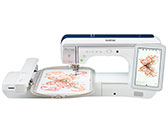Innov-is XP1
FAQs & Troubleshooting |
Basic procedure to sew stitches
- To avoid injury, pay special attention to the needle while the machine is in operation. Keep your hands away from moving parts while the machine is in operation.
- Do not stretch or pull the fabric during sewing. Doing so may lead to injury.
- Do not use bent or broken needles. Doing so may lead to injury.
- Do not attempt to sew over basting pins or other objects during sewing. Otherwise, the needle may break and cause injury.
- If stitches become bunched, lengthen the stitch length setting before continuing sewing. Otherwise, the needle may bend or break.
First, perform a trial sewing, using a piece of fabric and thread that are the same as those used for your project.
-
Prepare the appropriate needle and thread for the type of fabric.
For details, refer to "Combination of fabric, thread and needle".
If necessary, replace the needle.
For details, refer to "How do I change the needle ?".For safety and best sewing results, use thread and needle appropriate for the fabric that you wish to sew.
If the combination of the fabric, thread and needle is not correct, it may cause sewing problems or result in a poor finish to your sewing project. -
Wind thread onto a bobbin, and then install it into the machine.
For details, refer to "How do I wind the bobbin?" , "How do I set the bobbin ?". -
Thread the upper thread.
For details, refer to "How do I thread my machine ?". -
Touch Sewing key on the LCD screen to display the utility stitches or character/decorative stitch patterns.
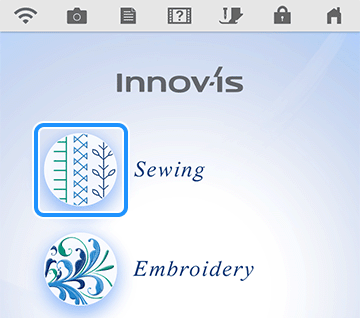
-
Select the category you want.
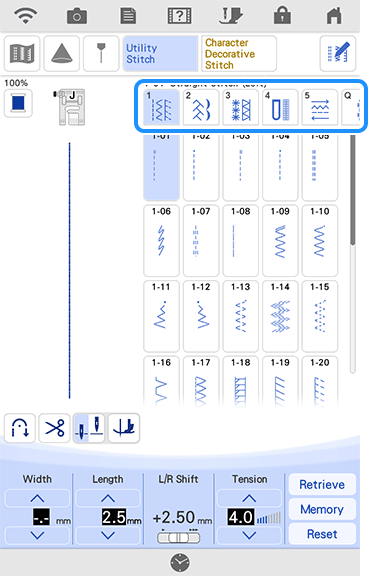
-
Touch the key of the stitch you want to sew.
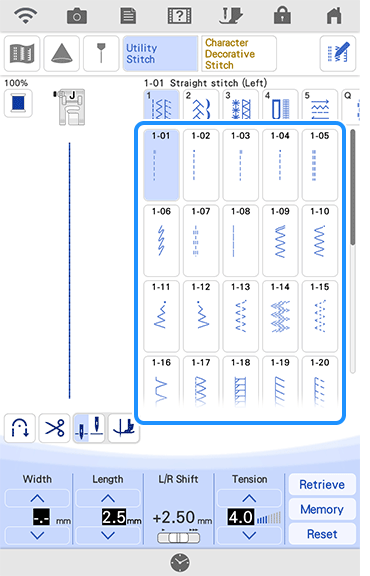
-
If necessary, change to the desired stitch width or stitch length.
For details, refer to "How do I adjust a stitch width or length?".
-
If necessary, change to the desired stitch width or stitch length.
-
Check which presser foot is indicated in the upper-left corner of the screen, and then install the presser foot.
In this procedure, the zigzag foot "J" is installed.
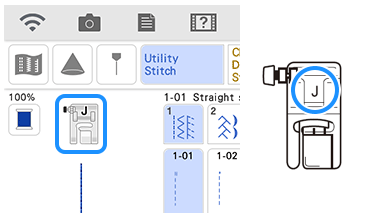
For details on changing the presser foot, refer to "How do I remove or attach the presser foot ?".
Always use the correct presser foot. If the wrong presser foot is used, the needle may strike the presser foot and bend or break, possibly resulting in injury. Refer to "Stitch Setting Chart" on the operation manual for presser foot recommendations.
-
Set the fabric under the presser foot. Hold the fabric and thread in your left hand, and press
 (Needle position button) to set the needle in the sewing start position.
(Needle position button) to set the needle in the sewing start position.
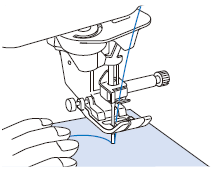
-
Press
 (Presser foot lifter button) to lower the presser foot.
(Presser foot lifter button) to lower the presser foot.
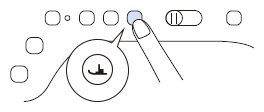
-
Adjust the sewing speed with the speed control slide.
(when using utility stitches)
You can use this slide to adjust sewing speed during sewing.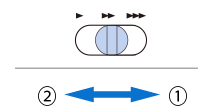
(1) Fast
(2) Slow -
Press the "Start/Stop" button to start sewing.
(When the foot controller is plugged in, slowly press down on the foot controller.)
Guide the fabric lightly by hand.
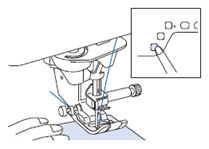 When the foot controller is being used, you cannot start sewing by pressing the "Start/Stop" button.
When the foot controller is being used, you cannot start sewing by pressing the "Start/Stop" button. -
Press the "Start/Stop" button again to stop sewing.
(When the foot controller is plugged in, remove your foot from the foot controller.)
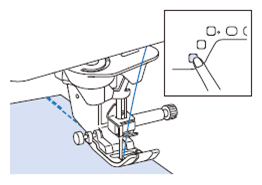
-
Press
 (Thread cutter button) to trim the upper and bobbin threads.
(Thread cutter button) to trim the upper and bobbin threads.
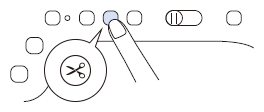
>> The needle will return to the up position automatically.-
Do not press
 (Thread cutter button) after the threads have been cut. Doing so could tangle the thread or damage the machine.
(Thread cutter button) after the threads have been cut. Doing so could tangle the thread or damage the machine. -
Do not press
 (Thread cutter button) when there is no fabric set in the machine or during machine operation. The thread may tangle, possibly resulting in damage.
(Thread cutter button) when there is no fabric set in the machine or during machine operation. The thread may tangle, possibly resulting in damage.
When cutting thread such as nylon monofilament thread, or other decorative threads, use the thread cutter on the left side of the machine.
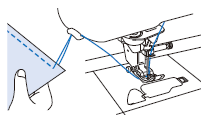
-
Do not press
-
When the needle has stopped moving, press
 (Presser foot lifter button) to raise the presser foot and remove the fabric.
(Presser foot lifter button) to raise the presser foot and remove the fabric.

-
Check the sewing finish. If necessary, adjust the thread tension.
For details, refer to "How to adjust the thread tension".
